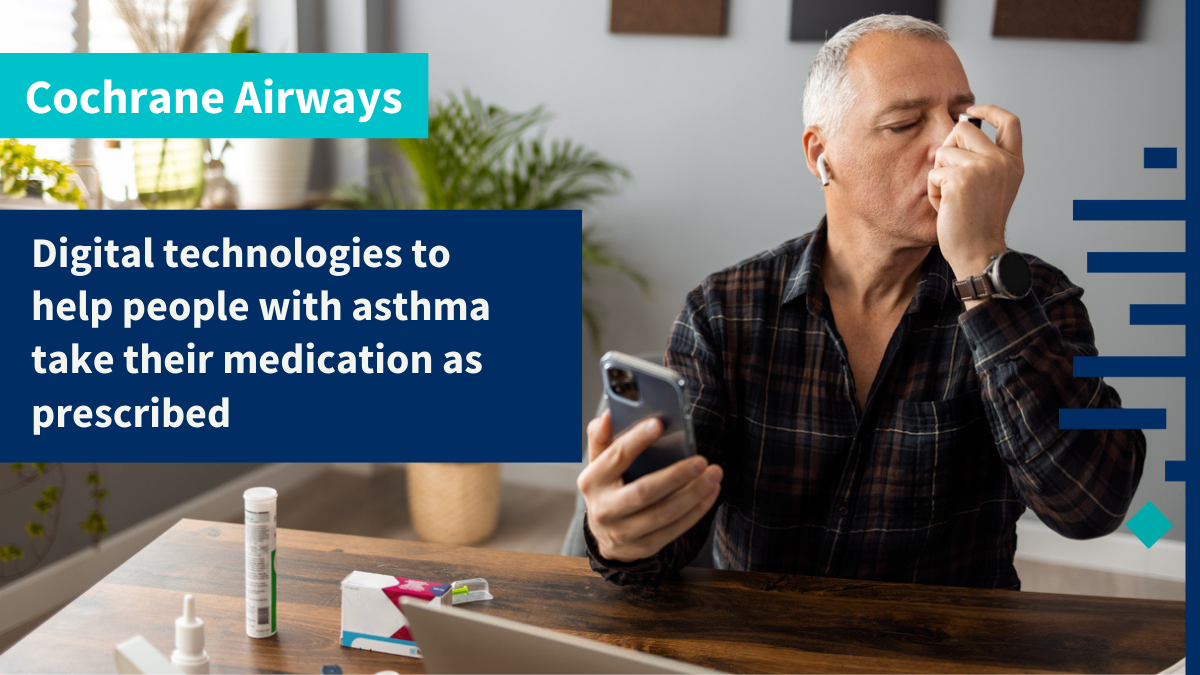Asthma is one of the most common long-term conditions worldwide. There are effective medicines available to treat symptoms, such as inhalers containing steroids. However, for best effect, maintenance medication need to be taken as prescribed. Many people do not take their medication, due to busy schedules and the belief that medication is only needed short-term. This is known as ‘non-adherence’, which can lead to more symptoms and attacks. Non-adherence is a major health problem; achieving adherence is very important to prevent attacks and reduce the risk of death. In healthcare there is increasing use of digital interventions such as mobile phones, text messages, and ‘smart’ inhalers that can feed back information about medication-taking. However, there is limited evidence on whether these technologies work to improve asthma medication-taking or improve symptoms.
This review aimed to find out whether digital technologies really work to improve asthma medication-taking, and whether this improved adherence leads to improvements in asthma symptoms and other benefits.
Study characteristics
We found 40 studies including more than 15,000 adults and children with asthma. Studies ranged from about 2 weeks to 24 months’ duration, so we cannot say whether these methods are effective in the long term (a long period of years). We searched multiple information sources to identify relevant studies. This review is current as of June 2020. Looking at the data, we aimed to find out whether digital technologies helped people with asthma to take their medication as prescribed, and whether people who used the technology had better asthma control, and fewer asthma attacks, than those who did not use the technology.
Key results
People with asthma who were given the digital technology to support asthma medication-taking were better at taking their medication as prescribed compared to people who did not get the technology; 15% more people (likely to be somewhere between 8% and 22%) took their medication as prescribed when they received the digital technology, compared to those who did not (who took their medication on average 45% of the amount prescribed).
Importantly, people who got the digital technology had much better asthma control and half the risk of asthma attacks (likely somewhere between 32% and 91%), which has direct benefits for reducing the risk of asthma-related deaths. We saw improvements in quality of life and lung function, but the effect on lung function was small and may be of limited clinical relevance.
No improvements were seen in unscheduled healthcare visits. There was not enough information to tell us about the effect of digital technologies on time off work or school or the cost-benefits, nor whether there are any harms. Technologies were generally acceptable to patients. Certain types of technologies such as ‘smart’ inhalers and text messages seemed to be better for improving medication-taking than other technology types, although the small number of studies means we cannot be certain that these technologies definitely work better than others.

Quality of the information
There is some uncertainty about our results because the studies were quite different from each other. These differences mean that we cannot be completely sure what the real benefit is, as the benefits may be due to other factors not directly related to the technology – for example, being involved in a study can improve medication-taking. Sometimes the studies did not give us enough information for us to include them with the other studies to work out their effectiveness. We had concerns about a quarter of the studies where people did not finish the study, and we were uncertain whether studies reported everything they measured.
Practising GPs and authors on this Cochrane review Anna De Simoni and Chris Griffiths discuss using apps and digital tools with patients with asthma, they explain,
“The evidence in this review gives us more confidence to discuss their use. From this review we know electronic adherence monitors and text messages can help patients make more informed choices.”
Key message
The studies we found suggest that digital technologies may help people with asthma take their medication better, improve their asthma control, and potentially halve their risk of asthma attacks, compared with people who did not get the technology. Certain types of digital technologies, such as text-message interventions, may work better than others. However, we have some uncertainties about the quality of the information reported in some studies, and the small number of studies for the different technology types, which means we cannot be 100% certain of their benefits.
Author Amy Chan explains,
“Digital technologies that aim to improve medication taking can increase people taking their medication in way it has been prescribed by 15%, and improve asthma control and quality of life. Technologies that use text messages or electronic adherence monitors appear to be particularly effective for improving people taking their medication as prescribed.”




